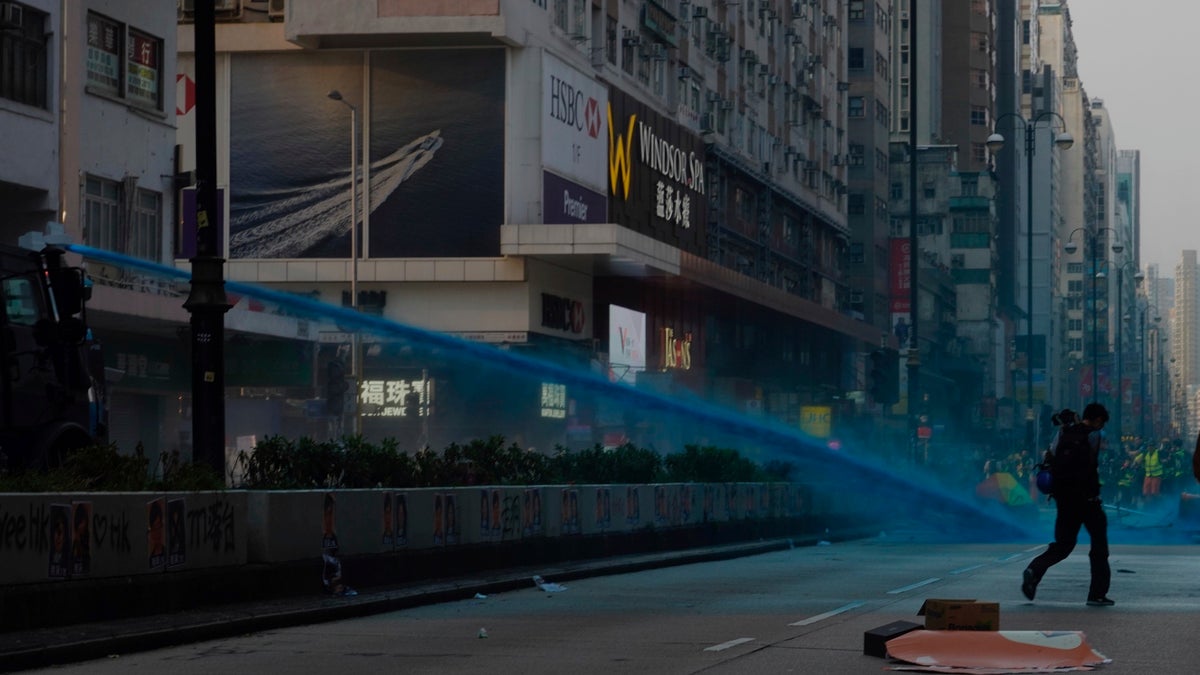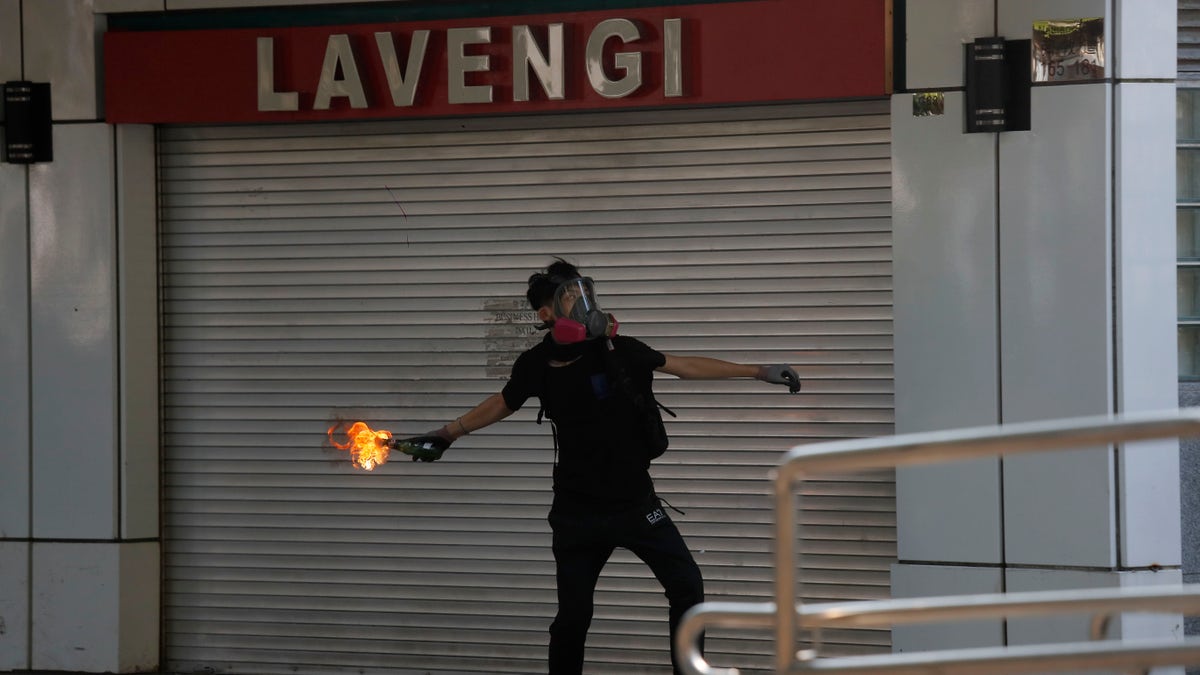Fox News Flash top headlines for Oct. 20
Fox News Flash top headlines for Oct. 20 are here. Check out what's clicking on FoxNews.com
Thousands of pro-democracy Hong Kong protesters took to the streets on Sunday, defying a ban by Chinese authorities on the rally as violence has continuously escalated over the past several months.
Some were seen throwing Molotov cocktails as police attempted to disperse the crowd by using tear gas and a water cannon.
Protest leaders carried a black banner that read "Five main demands, not one less," as they attempt to gain more freedom and political rights from the Chinese government.
HONG KONG MURDER SUSPECT WHO SPARKED PROTESTS READY TO TURN HIMSELF IN, CARRIE LAM SAYS

Thousands of protesters march during a rally in Hong Kong, Sunday, Oct. 20, 2019. Hong Kong protesters again flooded streets on Sunday, ignoring a police ban on the rally and demanding the government meet their demands for accountability and political rights. (AP Photo/Mark Schiefelbein)
“We don’t care whether they will approve the march or not, our fight for justice in the face of tyranny goes on anyway,” said Victor, 24, who told the Washington Post he returned to his home city from New Zealand to participate in the protest. “The movement is spreading everywhere, all around the world.”

Protesters face police tear smoke in Hong Kong, Sunday, Oct. 20, 2019. Hong Kong protesters again flooded streets on Sunday, ignoring a police ban on the rally and setting up barricades amid tear gas and firebombs. (AP Photo//Mark Schiefelbein)
Police presence was beefed up for the rally on Sunday in an effort to combat the protesters who were estimated to number around 350,000, according to the Washington Post. The protesters reportedly involved families -- including women, children and the elderly.

Police arrive to chase away protestors in Hong Kong, Sunday, Oct. 20, 2019. Hong Kong protesters again flooded streets on Sunday, ignoring a police ban on the rally and setting up barricades amid tear gas and firebombs. (AP Photo/Kin Cheung)
Authorities were seen using a water cannon filled with stinging blue dye to blast protesters, who barricaded streets at multiple areas in Kowloon, as well as outside an area mosque. The spray reportedly left bystanders choking and vomiting, according to the outlet.

Police use blue dyed water to disperse protestors in Hong Kong, Sunday, Oct. 20, 2019. Hong Kong protesters again flooded streets on Sunday, ignoring a police ban on the rally and setting up barricades amid tear gas and firebombs. (AP Photo/Vincent Yu)
During the rally, protesters also trashed local businesses they perceived as pro-Beijing.

Protesters set fire to a Xiaomi shop at Nathan road in Hong Kong, Sunday, Oct. 20, 2019. Hong Kong protesters again flooded streets on Sunday, ignoring a police ban on the rally and setting up barricades amid tear gas and firebombs. (AP Photo/Vincent Yu)
As the demonstration continued into late Sunday afternoon, protesters were seen tearing up bricks and throwing them -- as well as Molotov cocktails -- at police stations, setting barricades on fire and smashing up subway stations, according to the Washington Post.

A protester throws a Molotov cocktail at a police station in Hong Kong, Sunday, Oct. 20, 2019. Hong Kong protesters again flooded streets on Sunday, ignoring a police ban on the rally and demanding the government meet their demands for accountability and political rights. (AP Photo/Kin Cheung)
Police countered the protests throughout the day by using tear gas to violently disperse the crowds.

Protesters face police tear smoke in Hong Kong, Sunday, Oct. 20, 2019. Hong Kong protesters again flooded streets on Sunday, ignoring a police ban on the rally and setting up barricades amid tear gas and firebombs. (AP Photo//Mark Schiefelbein)
Some of the protesters were seen using power tools to construct sturdier barricades they hoped would hold back police more efficiently.
BROOKLYN NETS FANS TARGET LEBRON JAMES, SUPPORT HONG KONG IN BARCLAYS CENTER PROTEST
Many wore masks in defiance of a recent ban on face coverings at public gatherings, which authorities implemented because they consider facial recognition technology a powerful tool in finding protesters.
Organizers said they wanted to use their right to protest as guaranteed by the city's constitution despite the risk of arrest.
"We're using peaceful, rational, nonviolent ways to voice our demands," Figo Chan, vice convener of the Civil Human Rights Front, told reporters. "We're not afraid of being arrested. What I'm most scared of is everyone giving up on our principles."
The group has organized some of the movement's biggest protest marches. One of its leaders, Jimmy Sham, was attacked on Wednesday by assailants wielding hammers.
On Saturday, Hong Kong police arrested a 22-year-old man on suspicion of stabbing a teenage activist who was distributing leaflets near a wall plastered with pro-democracy messages. A witness told local broadcaster RTHK that the assailant shouted afterward that Hong Kong is "a part of China" and other pro-Beijing messages.
The protest movement sprang out of opposition to a government proposal for an extradition bill that would have sent suspects to mainland China to stand trial, and then ballooned into broader demands for full democracy and an inquiry into alleged police brutality.
CLICK FOR THE ALL-NEW FOXBUSINESS.COM
The Associated Press contributed to the report





















